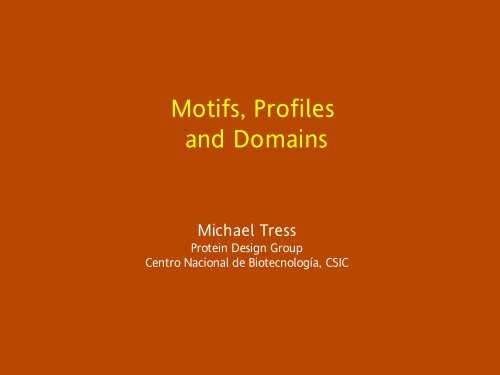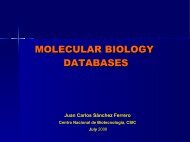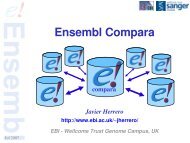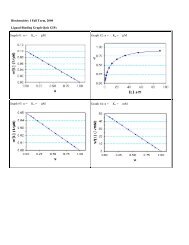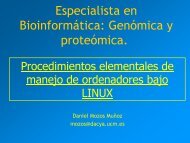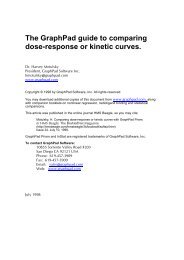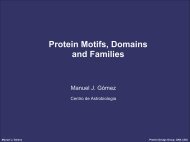Patterns, Profiles, Domains and Motifs Theory - CNB - Protein ...
Patterns, Profiles, Domains and Motifs Theory - CNB - Protein ...
Patterns, Profiles, Domains and Motifs Theory - CNB - Protein ...
Create successful ePaper yourself
Turn your PDF publications into a flip-book with our unique Google optimized e-Paper software.
<strong>Motifs</strong>, <strong>Profiles</strong><br />
<strong>and</strong> <strong>Domains</strong><br />
Michael Tress<br />
<strong>Protein</strong> Design Group<br />
Centro Nacional de Biotecnología, CSIC
Comparing Two <strong>Protein</strong>s<br />
Sequence Alignment<br />
Determining the pattern of<br />
evolution <strong>and</strong> identifying<br />
conserved regions that may be<br />
of structural or functional<br />
importance.<br />
Structure Alignment<br />
Structure is more conserved<br />
than sequence. If structural<br />
similarity existsiit is still<br />
possible to infer common<br />
ancestry, even in the absence<br />
of sequence similarity
Sequence Analysis<br />
Aims<br />
<br />
<br />
<br />
<br />
<br />
<br />
To identify similarity between sequences.<br />
To deduce common ancestry from sequence similarity.<br />
Sequence classification<br />
Sequence similarity based function prediction.<br />
Sequence similarity based structure prediction<br />
The prediction of functional <strong>and</strong> physical interaction between<br />
proteins
Chaperones (dnak), <strong>Protein</strong>s involved in bacterial cell wall<br />
production (ftsA, mreB), hexokinases (hxk), actin (act)
Hsc70<br />
Actin<br />
DnaK<br />
FtsA<br />
Hexokinase<br />
MreB
FUNCTION PREDICTION PROTOCOL<br />
Based on sequence similarity, structural analyses <strong>and</strong> information about interacting partners.<br />
<strong>Protein</strong><br />
primary<br />
sequence<br />
<strong>Protein</strong> interactions<br />
characterization<br />
<strong>Protein</strong> structure analyses<br />
• SCOP / CATH classification<br />
• Functional sites mapped on<br />
structure<br />
Function prediction<br />
(molecular level)?<br />
Primary Database similarity search<br />
• SwissProt / UniProt<br />
• nr / SP+SPTrEMBL<br />
• COG / KOG<br />
• PDB<br />
Function prediction<br />
(cellular level)?<br />
<strong>Protein</strong> structure prediction<br />
• 1D features<br />
• 3D structure / fold prediction<br />
Orthologs / paralogs<br />
MSA<br />
Family assignment<br />
Functional residues<br />
Phylogenetic profile<br />
Gene neighbourhood<br />
Function prediction?<br />
Secondary Database similarity search<br />
• Prosite<br />
• Pfam<br />
• SMART<br />
• PRINTS<br />
• BLOCKS<br />
• InterPro<br />
<strong>Protein</strong> motifs<br />
Domain organization<br />
Family assignment<br />
Function prediction?<br />
Known / Predicted structure
Why Function<br />
Prediction is<br />
Important<br />
The huge quantity of sequenced deposited in the protein databanks<br />
by genome sequencing projects will be dwarfed by the sequences<br />
from the environmental sequencing projects that are currently<br />
underway.<br />
There is a growing imbalance between the number of sequences in<br />
databases <strong>and</strong> the information about structure <strong>and</strong> function regarding<br />
those sequences.<br />
Functional <strong>and</strong> structural predictions could save a lot of time <strong>and</strong><br />
effort <strong>and</strong> money, <strong>and</strong> they provide information about systems that<br />
are not experimentally treatable.
Why Pattern Recognition Methods Work. Mostly.<br />
Sequence<br />
Structure<br />
Function<br />
The amino acid sequence of a protein<br />
determines its structure - in general<br />
similar sequences fold into similar<br />
structures.<br />
The structure of a protein determines<br />
its function. And in general similar<br />
protein structures perform similar<br />
functions.<br />
Therefore, function prediction should be<br />
a simple matter of detecting similarity.<br />
Chaperonins<br />
Location
However, the relation between sequence<br />
similarity <strong>and</strong> function is far from simple.
Two Conclusions Drawn from Comparisons of<br />
<strong>Protein</strong> Sequences<br />
First, protein sequences can be grouped in clusters or families based<br />
on sequence similarity.<br />
Second, this similarity may be restricted to short stretches of<br />
sequence. These conserved regions of sequence are generally<br />
regions of functional importance.
Clusters<br />
Clustering techniques aim to identify groups of sequences that are<br />
maximally similar between them, <strong>and</strong> minimally similar to sequences in<br />
other clusters.<br />
The terms superfamily, family <strong>and</strong> subfamily are often used. All the<br />
members of a superfamily, family or subfamily, are evolutionarily related.<br />
The members of a superfamily generally have a similar structure, even<br />
though it may not be possible to detect sequence similarity. The members of<br />
a subfamily have clear sequence similarity <strong>and</strong> the same function.
1. <strong>Patterns</strong> <strong>and</strong> <strong>Profiles</strong><br />
Constructed from multiple alignments of evolutionarily related<br />
sequences. They include consensus sequences, regular expressions,<br />
profiles (PSSMs) <strong>and</strong> hidden Markov models (HMMs).<br />
2. Conserved sub-sequences<br />
<strong>Domains</strong> are stretches of sequence that appear as modules within<br />
proteins. They are usually more obvious structurally. Certain domains<br />
can be found in a wide range of proteins. Domain shuffling is an<br />
accepted mechanism of protein evolution.<br />
<strong>Motifs</strong> are short, conserved sub-sequences that usually correspond to<br />
active or functional sites.
<strong>Motifs</strong><br />
<strong>Protein</strong>s from the same family are often characterised by short<br />
conserved regions that are usually related with function, such as binding<br />
sites or active sites.<br />
The structural <strong>and</strong> functional restrictions placed on these motifs means<br />
that they are usually conserved even over large evolutionary distances.<br />
However, they are not usually detectable by sequence search<br />
techniques such as BLAST or FASTA.<br />
Instead there are motif databases, <strong>and</strong> tools for searching for motifs in<br />
sequences <strong>and</strong> for searching for sequences with a certain motif.
HemK<br />
- an adenine<br />
methyltransferase?<br />
The “NPPY” motif is<br />
characteristic of the<br />
DNA methylase<br />
family.
However HemK<br />
turns out to be the<br />
first known<br />
glutamine<br />
methyltransferase
<strong>Domains</strong><br />
<strong>Domains</strong> are usually visible structurally, sometimes they are more<br />
obvious than others though ...<br />
Heat shock operon<br />
repressor HrcA<br />
Diphtine synthase
<strong>Domains</strong><br />
<strong>Domains</strong> often are associated with a single function, but<br />
sometimes both domains are involved – eq 1hpuD <strong>and</strong> T0200
<strong>Domains</strong> <strong>and</strong> Chains<br />
ATP<br />
subunit<br />
Molecular chaperonin GroEL<br />
heptamer<br />
(Dr Jianpeng Ma, Harvard Univ.)
Consensus<br />
Sequences<br />
ALRDFATHDDF<br />
SMTAEATHDSI<br />
ECDQAATHEAS<br />
80% XXXXXATHXXX<br />
50% XXXXXATHDXX<br />
Regular<br />
Expressions<br />
ALRDFATHDDF<br />
SMTAEATHDSI<br />
ECDQAATHEAS<br />
xxxxxATH[DE]xx<br />
•N terminal: <br />
• Any amino acid: x<br />
• Ambiguity: [A,B…] A or B...<br />
•<br />
or {A,B..} anything but A or B…<br />
• Repeats: A(2,4) - A-A o A-A-A o A-A-A-A<br />
[AC]-x-V-x(4)-{E,D}<br />
[Ala or Cys]-any-Val-any-any-any-any-{any but Glu or Asp}
PSI-BLAST<br />
PSI-BLAST (Position Specific Iterated BLAST) is accesible at the<br />
NCBI web server. Like BLAST, PSI-BLAST performs database<br />
searches with query sequences as input.<br />
After the first BLAST search a multiple sequence alignment is<br />
constructed from significant local alignments found in the first pass.<br />
From that multiple alignment a profile (or PSSM) is built .
<strong>Profiles</strong><br />
F K L L S H C L L V<br />
F K A F G Q T M F Q<br />
Y P I V G Q E L L G<br />
F P V V K E A I L K<br />
F K V L A A V I A D<br />
L E F I S E C I I Q<br />
F K L L G N V L V C<br />
A -18 -10 -1 -8 8 -3 3 -10 -2 -8<br />
C -22 -33 -18 -18 -22 -26 22 -24 -19 -7<br />
D -35 0 -32 -33 -7 6 -17 -34 -31 0<br />
E -27 15 -25 -26 -9 23 -9 -24 -23 -1<br />
F 60 -30 12 14 -26 -29 -15 4 12 -29<br />
G -30 -20 -28 -32 28 -14 -23 -33 -27 -5<br />
H -13 -12 -25 -25 -16 14 -22 -22 -23 -10<br />
I 3 -27 21 25 -29 -23 -8 33 19 -23<br />
K -26 25 -25 -27 -6 4 -15 -27 -26 0<br />
L 14 -28 19 27 -27 -20 -9 33 26 -21<br />
M 3 -15 10 14 -17 -10 -9 25 12 -11<br />
N -22 -6 -24 -27 1 8 -15 -24 -24 -4<br />
P -30 24 -26 -28 -14 -10 -22 -24 -26 -18<br />
Q -32 5 -25 -26 -9 24 -16 -17 -23 7<br />
R -18 9 -22 -22 -10 0 -18 -23 -22 -4<br />
S -22 -8 -16 -21 11 2 -1 -24 -19 -4<br />
T -10 -10 -6 -7 -5 -8 2 -10 -7 -11<br />
V 0 -25 22 25 -19 -26 6 19 16 -16<br />
W 9 -25 -18 -19 -25 -27 -34 -20 -17 -28<br />
Y 34 -18 -1 1 -23 -12 -19 0 0 -18<br />
<strong>Profiles</strong> are built based on the<br />
frequency of each amino acid at<br />
each position in the alignment.<br />
The relative frequency of each<br />
amino acid (or the no<br />
appearance) are weighted based<br />
on observed frequencies.<br />
A is less probable than M because<br />
although it doesnt appear we know<br />
that M is simliar to L, I, V y F.
PSI-BLAST II<br />
This profile is then used to search the database again, <strong>and</strong> any<br />
new significant hits are incorporated to the profile for further<br />
searches of the database.<br />
The process iterates an arbitrary number of times or until no new<br />
sequences can be found in the database.
Hidden Markov Models I<br />
Hidden Markov models (HMMs) are statistical models of sequences.<br />
They are similar to PSSMs, but the weights are calculated according<br />
to a probabilistic model that takes into account the previous<br />
positions.
Hidden Markov Models II<br />
The model has three residues or states (m 1<br />
, m 2<br />
, m 3<br />
) with 20<br />
probabilities to be a residue (bars), one state which is insertion (eg i 0<br />
)<br />
<strong>and</strong> one state which relates to deletion (eg d 1<br />
). The arrows represent<br />
the probability of the transition between each state.
Motif Construction<br />
Known motifs (published or found in known families)<br />
Eg PROSITE<br />
Empirical motifs: obtained directly from alignments. In some cases<br />
their significance is unknown.<br />
Eg Pfam.
Conocido<br />
De alineamiento<br />
Extracción<br />
Expresión<br />
regular<br />
perfil<br />
HMM<br />
Base de<br />
datos<br />
de<br />
secuencias<br />
Motivo<br />
Base de<br />
datos<br />
de motivos<br />
Búsqueda<br />
Iterativo<br />
Minimiza falsos<br />
positivos
Using Databases <strong>and</strong> Tools Based on <strong>Motifs</strong> <strong>and</strong><br />
<strong>Domains</strong><br />
1. Function Prediction: Identifying motifs in a query sequence<br />
2. Finding remote similarities: Searching all sequences in a database<br />
with a certain motif.
Function Prediction<br />
Base de datos<br />
de motivos<br />
A<br />
B<br />
Documentación<br />
A+ B función
Searching for Remote Similarity<br />
with <strong>Motifs</strong><br />
Base de datos<br />
de secuencias
Tools<br />
Secue<br />
ncia<br />
?<br />
Psi-BLAST<br />
PPsearch<br />
pfsearch<br />
HMMER<br />
Motivo<br />
?<br />
Base de datos<br />
de secuencias<br />
pfscan<br />
ScanProsite<br />
Base de datos<br />
de motivos
Databases<br />
PROSITE Regular Expressions <strong>and</strong> profiles based on known motifs<br />
from SwissProt.<br />
BLOCKS<br />
<strong>Profiles</strong>, based on PROSITE.<br />
PRINTS<strong>Profiles</strong>, based on known motifs<br />
Pfam <strong>Profiles</strong> from HMM. <strong>Motifs</strong> generated utomatically using<br />
SwissProt + SP-TrEMBL<br />
SMART<strong>Domains</strong> identified with PSI-BLAST <strong>and</strong> HMMs.<br />
InterProHierarchical database of domains <strong>and</strong> motifs that integrates<br />
information from Prosite, PRINTS, Pfam, Prodom, SMART <strong>and</strong><br />
TIGRFAMs.
Información<br />
SP-TrEMBL<br />
Pfam<br />
SwissProt<br />
PROSITE<br />
BLOC<br />
KS<br />
PRI<br />
NTS<br />
Precisión<br />
Expresiones<br />
regulares<br />
Perfiles<br />
simples múltiples<br />
HMMs
This presentation contains material from:<br />
Manuel J Gómez, CAB<br />
Oswaldo Trelles, UMA<br />
Joaquín Dopazo, CNIO<br />
Paulino Gómez Puertas, CBM


